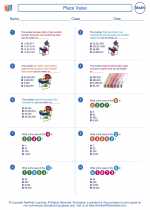Place Value
Place value is the value of a digit based on its position in a number. In our decimal number system, each digit's place value is ten times the place value of the digit to its right. Understanding place value is crucial for understanding how numbers are composed and how to perform operations with them.
Understanding Place Value
To understand place value, we need to look at the positions of the digits in a number. The positions are called ones, tens, hundreds, thousands, and so on, from right to left. For example, in the number 3,682:
- The digit 2 is in the ones place
- The digit 8 is in the tens place
- The digit 6 is in the hundreds place
- The digit 3 is in the thousands place
Place Value Chart
A place value chart is a helpful tool for visualizing the value of each digit in a number. It organizes the digits by their place value to help understand the magnitude of each digit in the number.
| Thousands | Hundreds | Tens | Ones |
|---|---|---|---|
| 3 | 6 | 8 | 2 |
Example Problems
Let's look at some example problems to apply our understanding of place value.
Problem 1:
What is the value of the digit 5 in the number 7,549?
Answer: The digit 5 is in the hundreds place, so its value is 500.
Problem 2:
Write the number 4,327 in expanded form.
Answer: 4,000 + 300 + 20 + 7
Place Value and Operations
Understanding place value is essential for performing addition, subtraction, multiplication, and division with larger numbers. It helps us to correctly align the digits and perform operations on numbers with multiple place values.
Practice Problems
Now that we've covered the basics of place value, it's time to practice with some problems. Here are a few to get started:
- What is the value of the digit 9 in the number 9,876?
- Write the number 6,205 in expanded form.
- Add 3,421 and 2,367.
Remember to pay attention to the place value of each digit when solving these problems!
[Place Value] Related Worksheets and Study Guides:
.◂Math Worksheets and Study Guides Fifth Grade. Place Value
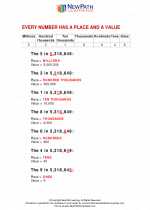
 Worksheet/Answer key
Worksheet/Answer key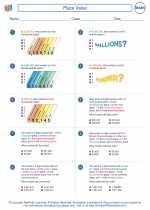
 Worksheet/Answer key
Worksheet/Answer key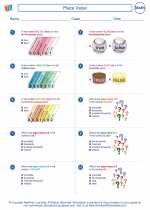
 Worksheet/Answer key
Worksheet/Answer key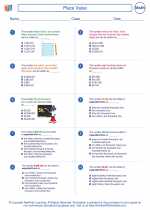
 Worksheet/Answer key
Worksheet/Answer key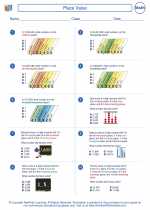
 Worksheet/Answer key
Worksheet/Answer key
 Worksheet/Answer key
Worksheet/Answer key